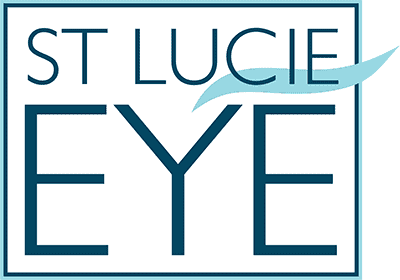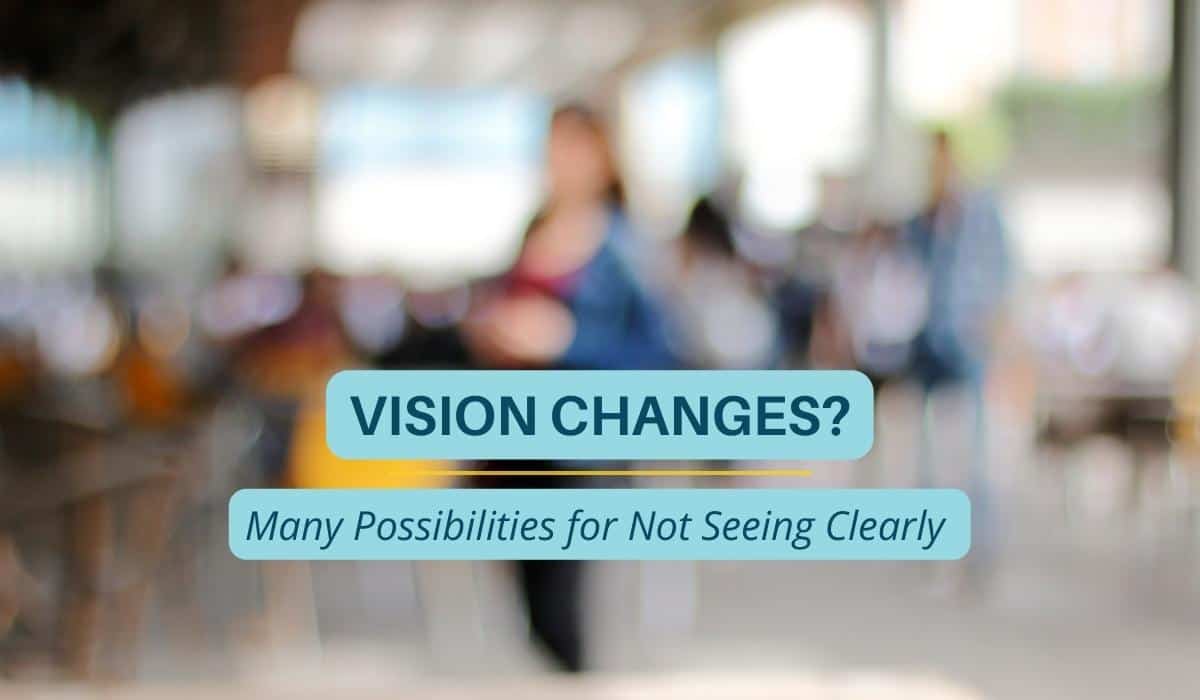Many Possibilities for Visual Changes
Have you noticed changes in your vision lately? Fluctuations in how you see can be annoying, concerning, and troublesome for sure.
But the real challenge comes in discovering the real cause for your new onset of blurry vision or watery eyes.
Even with a wealth of reliable information online, it’s nearly impossible to self-diagnose. If you’ve ever ventured down the search rabbit hole with Doctor Google or Chat.MD, you know just how frustrating it can be to uncover the root cause.
Maybe you’re struggling to see things up close because you’re now ‘that age’ or maybe you experience blurred vision after a long day of constantly staring at digital screens.
Whatever your symptoms, we’ll delve into some of the most common reasons for vision changes in this blog post and give you the tools to understand possible causes.
And finally, we’ll encourage you to seek a professional eye exam if symptoms continue.
The truth is, many vision symptoms are similar and can be an underlying sign of more serious eye conditions. The only way to determine the real cause of your vision changes is with a proper eye exam.
Refractive Errors – What’s Age Got to Do with it?
Refractive errors are the most common type of vision problem across all ages, affecting millions of people worldwide. It’s the typical reason someone needs glasses or contacts to see better, and the most common reason for interest in laser, or LASIK surgery.
When any portion of the eye is shaped irregularly, light will not focus properly on the retina, causing blurred vision, or refractive errors.
In a healthy and perfectly shaped eye, light enters the cornea at the front of the eye and passes through a clear lens. Light is then focused onto the retina at the back of the eye where it travels to the optic nerve and visual cortex of the brain.
The function of the eye is similar to how film cameras work. Think of the front of the eye as the camera aperture and lens. Light enters and is focused onto film (retina) where it develops. Accurate focus depends on each part of the eye working in order and being in the right shape and condition.
Just like in the camera example, any number of things can alter how the eye processes images; including eyeballs that are too short (hyperopia), too long (myopia), or irregularly shaped (astigmatism). The result can be out of focus, low resolution, and blurry images.
The four most common types of refractive errors are nearsightedness (myopia), farsightedness (hyperopia), corneal distortion (astigmatism), and age–related near vision changes (presbyopia).
Nearsightedness (myopia) occurs when the eyeball is too long, or the cornea is too steep. This causes light to focus in front of the retina, resulting in blurred distance vision. Myopia is a common refractive error, affecting nearly 30% of the population in the United States.
Farsightedness (hyperopia) is the opposite of myopia. It occurs when the eyeball is too short or the cornea is too flat, causing light to focus behind the retina. This results in blurred near vision and, in some cases, distance vision as well. Hyperopia is less common than myopia, but still affects a significant portion of the population.
Astigmatism is a refractive error that occurs when the cornea or lens is irregularly shaped, causing light to be focused unevenly on the retina. The normal cornea is the shape of a round ball; an abnormal cornea is shaped more like an oblong football. An abnormal curve to the cornea results in distorted or blurred vision, both up close and at a distance. Astigmatism is often present with nearsightedness or farsightedness but can also occur on its own.
Presbyopia is the age-related refractive error that affects your ability to see up close. With age, the natural lens within the eye becomes less flexible, making it harder to focus on close objects. This leads to difficulty reading or performing up-close tasks. Presbyopia affects nearly everyone to some degree, typically starting in the early 40s. Reading glasses are a simple and inexpensive solution for presbyopia.
While refractive errors are considered normal and easily treatable, many of the visual symptoms’ mimic signs of more serious eye problems. Vision changes should always be tested with a comprehensive eye exam to rule out signs of disease.
Digital Eye Strain – Not Your Grandmother’s Blue Light Special
First, the good news about digital devices. We know they keep us connected, informed and entertained, and most of us would not know what to do without their convenience. The bad news about digital devices is that we spend an enormous amount of time staring at them.
Prolonged use of digital devices such as computers, smartphones, and tablets can lead to digital eye strain or computer vision syndrome (CVS), causing eye discomfort, fatigue, and dryness. Other symptoms include headache, blurred vision, neck and shoulder pain, and difficulty focusing.
The reasons surrounding digital strain are many. First is that our eyes blink less frequently when looking at screens; from a normal 20 blinks per minute to just seven. Reduced blinking causes the protective moisture layer of the eye to evaporate, resulting in dryness, blurred vision and eye fatigue.
The second, more insidious cause of digital eye strain is the blue light emitted from electronic devices.
Blue light is a type of high-energy visible (HEV) light that we are exposed to every day, whether scrolling through social media or doing work on a computer for long hours. While this light is important for regulating our sleep-wake cycles and keeping us alert during the day, it can also cause significant damage to the delicate tissue of the retina.
The reason blue light is so harmful to the retina is because it has a shorter wavelength and higher energy than other colors of light. This means that it can penetrate deeper and cause damage to sensitive photoreceptor cells, leading to long-term vision problems like age-related macular degeneration – a condition that can cause vision loss and blindness.
There are several ways to reduce the risk of blue light-induced damage to the retina. One is to use blue light filters on digital screens or wear glasses with blue light filters. These filters help reduce the amount of blue light that enters the eye to minimize the risk of damage.
Another way to protect your eyes from excessive blue light is to follow the 20-20-20 rule. For every 20 minutes looking at a digital screen, take a 20 second break and focus on a distance 20 feet away. Additionally, blink more frequently to keep eyes lubricated, and use natural replacement tear drops throughout the day when eyes feel tired or dry.
If your vision remains fuzzy or your eyes consistently feel fatigued and tired when looking at digital screens, schedule an eye exam to rule out other causes.
Eye Diseases – Often Painless and Unnoticed
Eye disease is often sneaky and painless, beginning with symptoms similar to other, less serious conditions. Blurry vision, trouble focusing, and eye sensitivity are all common complaints that can happen with any number of eye problems, including some that lead to permanent vision loss.
While it’s not unusual to chalk-up symptoms to simply ‘getting older’, it’s also possible that subtle changes can be the beginning of more serious eye disease.
An eye exam is the only way to diagnose the following common eye diseases. Regular eye exams are recommended throughout your lifetime, but especially after age 40, the age when most eye disease begins.
Glaucoma
Glaucoma is a group of eye conditions that damage the optic nerve, responsible for sending visual signals to the brain. Glaucoma has a strong family history component and often develops slowly over time. A red flag for the disease is high pressure within the eye. Open-angle glaucoma is the most common type of the disease, affecting over three million Americans. Without treatment, glaucoma can lead to blindness. Symptoms of glaucoma include loss of peripheral vision, halos around lights, and blurred vision.
Cataracts
Cataracts begin when the natural lens inside of the eye becomes thick and cloudy. Symptoms include blurry vision, sensitivity to light and poor color contrast. Cataracts develop slowly over time so symptoms are often subtle at first. You may not even realize you have them until they’ve progressed enough to interfere with certain activities like driving or watching TV. Cataracts are a common condition of aging that affect over 20 million Americans. The condition can be corrected with a straightforward outpatient procedure that replaces the clouded lens with an artificial one to improve vision.
Macular Degeneration
Age-related macular degeneration (AMD) is the leading cause of blindness for people over sixty. The disease impacts a part of the retina called the macula and is responsible for the clear, central vision used to read and recognize faces. There are two different types of macular degeneration, but both can lead to devastating vision loss. Dry AMD is the more common type and progresses slowly over time. There is no treatment for dry macular, although a special formulation of vitamins called AREDS has been shown to slow the disease. Wet AMD is less common but considered more severe. The wet form can progress quickly and lead to permanent vision loss without treatment with eye injections. Symptoms of macular degeneration include blurriness, distortion, and blind spots in the center of vision.
Diabetic Retinopathy
Diabetic retinopathy is a complication of diabetes types I and II. It occurs over time as high blood sugar levels damage small blood vessels of the retina. Diabetic retinopathy affects 1 in 29 Americans and can cause severe vision loss and even blindness. Symptoms of diabetic retinopathy include blurred vision, floaters, and difficulty seeing at night. There are several treatments for diabetic eye disease including eye injections, laser treatments and retinal surgery. The best way to prevent complication of diabetic eye disease is to keep blood sugar levels at optimal levels and schedule regular eye exams to observe for any changes to the retina.
Dry Eye
Dry eye is a common condition that impacts the clear, outer layer of the eye called the cornea. Nearly 15 percent of Americans, especially those over age 40 are affected. Causes include hormonal changes, certain medications, and environmental factors like wind, humidity and temperature changes.
Dry eye occurs when there’s a disruption in the tear film layer. Either enough tears are not produced, they evaporate too quickly, or they contain the wrong mix of water and oil to protect the sensitive outer surface of the eye. Symptoms of dry eye can be quite painful leading to blurred vision, increased light sensitivity and a gritty feeling in the eye.
Fortunately, there are a number of effective treatments for dry eye, including over-the-counter artificial tears, prescription medications, and lifestyle changes to reduce environmental irritants.
No Need to Fear Changes in Vision
Changes in vision don’t have to be alarming. Many times, a change in eyeglasses or prescriptive medication can alleviate annoying symptoms. If eye disease is discovered, early treatment and follow-up can preserve vision for the long-term.
Make eye exams a regular part of your preventative health routine. Regular eye exams are the best solution to ward off unseen eye disease and get you on track to seeing everything the world has to offer.
Need more information? Contact St Lucie Eye at (772) 461-2020.


